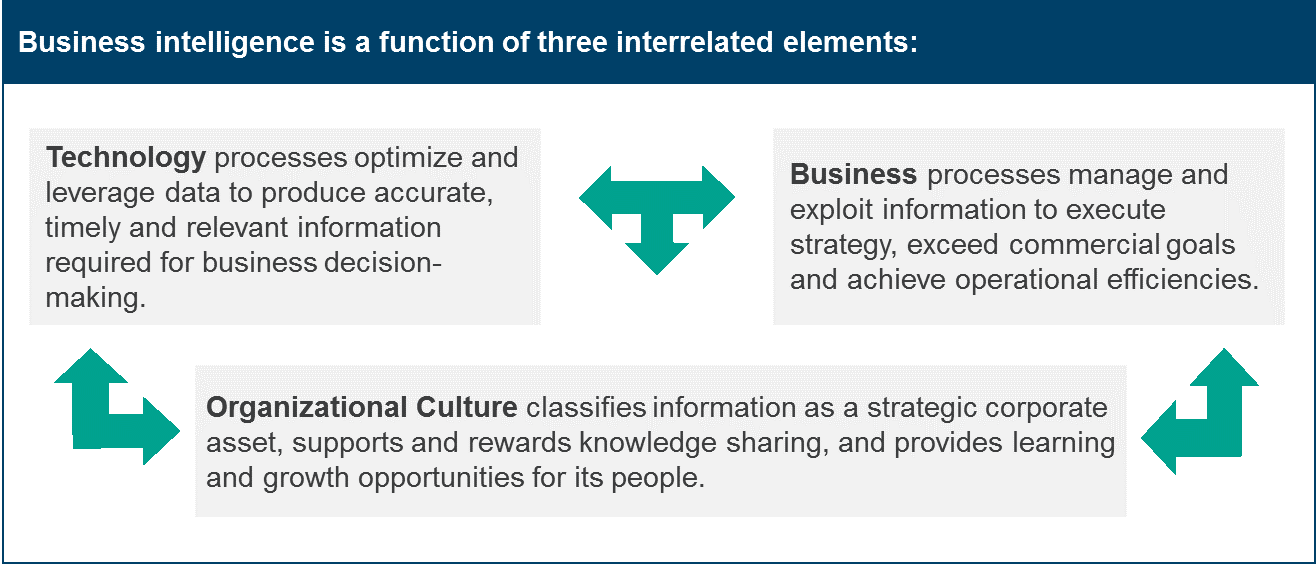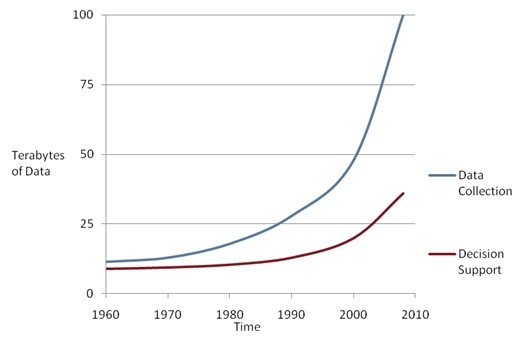Advanced Solutions for a Competitive Advantage
|Busi*ness In*tel”li*gence|, n. - the capacity to acquire and apply business knowledge, the act or state of knowing about your business; to understand and profit from experience; the internal development and sharing of information to create a competitive advantage.
Why Do We Care About Business Intelligence?
A company’s data is its lifeblood for competing and succeeding in the market. Multiple applications, databases, spreadsheets, and platforms store and maintain the data needed for strategic decision making. The combination of people, processes and technologies used to harvest this data and transform it into actionable information is known as business intelligence.
Business intelligence applications are not new—they have been around in different forms for almost 50 years with slightly different names, scopes and value propositions. This landscape is ever-changing, with real-time data analytics and data mining changing the current focus of business intelligence.
Today’s technology-centered world amounts to ever-growing data. Process automation and data capture capabilities are now pervasive. Data is being collected at an accelerated rate, beyond human capability to process it with the traditional manual ways. Much of this information is from new sources, such as social media feeds, blogs, web pages, web traffic logs, and other sources tied to the internet.

“Our ability to collect and store data exceeds our current capability to thoroughly process and exploit it.”
“There’s so much information flowing out of the groundswell, it’s like watching a thousand television channels at once. To make sense of it, you need to apply some technology, boiling down the chatter to a manageable stream of insights.”
Source: The New Know, Thornton May, 2009
Business intelligence is an approach for harnessing the power of information to create repeatable, sustainable operations and develop a competitive advantage. Companies that deploy business intelligence initiatives recognize these benefits over time:
- Information Quality. Business decision-makers rely on high-quality information to develop insight on emerging opportunities and challenges. Regulatory disclosure requirements force companies to develop transparent business and reporting processes.
- Communication Consistency. Common language and understanding leads to improved efficiency in business operations and reporting. Operational efficiency improves whenever communication is consistent.
- Information Leverage. Business intelligence vendors and technologies are maturing and providing solution benefits to companies in all industries worldwide. Combining third-party external data with your internal transactional data can provide new insight about your customers and your business.
- Organizational Knowledge. Sharing information increases organizational learning opportunities and helps develop organizational knowledge. Corporate knowledge management initiatives often include elements of business intelligence in their overall strategy.
- Competitive Advantage. Decision-making speed is enhanced by information that is accurate, timely and relevant. BI solutions provide the flexibility and scalability needed to grow with your business over time.
In large companies, business units tend to define metrics in the fashion that makes their business unit look the best. The result of this is that you end up with multiple reporting systems all providing slightly different “versions of the truth.” All of the metrics reported may be correct, but you must understand the context as to how they were calculated.
The value of business intelligence is derived from the use of a common framework for information management, reporting, and analytics. The discipline provided by the use of a common framework sets the foundation for consistent delivery, common understanding and standardized performance reporting across the organization.
The technology that supports business intelligence can come in many forms.
Signs That Your Organization Needs Business Intelligence Solutions
Providing accurate, timely and relevant information for business decision-making is an ongoing challenge. Organizations should consider utilizing business intelligence solutions if one or more of these activities or events occur on a frequent, informal basis:
- Developing information that is timely, accurate and relevant requires significant manual effort and coordination across multiple areas in your organization;
- Monitoring business activity, measuring performance, and reporting results on a consistent and repeatable basis is often difficult;
- Providing support for ad-hoc inquiries from executives or third parties requires extensive manual effort to produce and reconcile the results;
- Rising costs and conflicting priorities exist between several unrelated and unconnected BI initiatives happening throughout the organization;
- Measuring the effectiveness of marketing campaigns requires integrating several disparate sources of data from both within and outside of the organization; and
- Business users and executives complain that the application systems don’t provide the information they need to run their business.
Key Considerations
A key consideration when looking at implementing a data warehouse or business intelligence strategy is to understand how your organization will utilize the information. This will directly drive the types of tools required for the end users as well as the granularity and types of data required for publication to the end users.
Data Views – Looking at general measures for basic research
Activity Analysis – Using the information for status updates, dashboards, KPIs
Trending/Historic – Looking at the information over time to draw patterns and correlations
“What If” Analysis – Using the information to ask specific business questions and solve issues
Statistical Analysis – Using the information for data mining, regression analysis and determining patterns
Predictive Analysis – Using the information for strategic planning, scenarios and decision modeling
The following key questions should be asked prior to starting a business intelligence project and should be revisited often during project management. These items should all be included in the project charter.
- What is the total scope of the project (portions of the business to be covered)?
- Has an executive champion been identified and an executive steering committee formed?
- Is there an existing data source for all of the information?
- Will any of this information be used for public/financial reporting?
- Will the repository contain sensitive data, such as trade secrets or private client information?
- Are there currently existing reporting solutions that this project will look to replace?
- How real-time must the information be in order to be actionable?
- Will we be leveraging existing technology solutions for the project or bringing in new platforms?
- Do we have the required resources (both technical and functional) for the project?
- Are the timelines realistic for the project?
- Is the required data for the requested metrics attainable?
You must also consider who your target audience for the business intelligence is. Different consumers of business intelligence and data warehousing have varying value propositions for the systems. Your information technology (IT) department will be key in creating and supporting the end solution but they are not always a large consumer. The information technology group should be involved in all decisions regarding the interfaces and how the data is provided to the users, but typically the business should drive what data is provided and how metrics are calculated.
Who is the actual target audience for your project? A survey conducted by DM Review showed the following usage patterns within various departments. This helps to drive the rollout of the business intelligence tool as you can determine your “power users” versus the more casual users.

Rolling Out BI/Performance Management
Business intelligence is all about better understanding your business and its operations. As such, it is very important to start with a very solid understanding of the business and determine the key business metrics and drivers for your organization.
The outlined steps are not much different than those executed during any software development lifecycle. Business intelligence is slightly different than the typical scope—you must make sure that you are keeping the interests of the entire organization in mind, not just a specific business function or area. The best comparison is thinking about the System Development Life Cycle (SDLC) for an ERP system versus a billing solution—you must think much more holistically during the ERP implementation.
Key Performance Indicators (KPIs) in BI
A key performance indicator (KPI) is a numerical factor that allows management to quantitatively measure the performance of a business process, financial assets, operational/functional groups and the entire revenue cycle.
We use key performance indicators to view a snapshot of performance at a selected group, department, hospital or regional level; assess the current situation and determine the root causes of identified problem areas; set goals, expectations and financial incentives for any desired group; and trend the performance of the selected group over a period of time. KPIs increase management’s awareness and focus on improving identified problem areas.
Learn more about this topic by exploring these tools on KnowledgeLeader:
